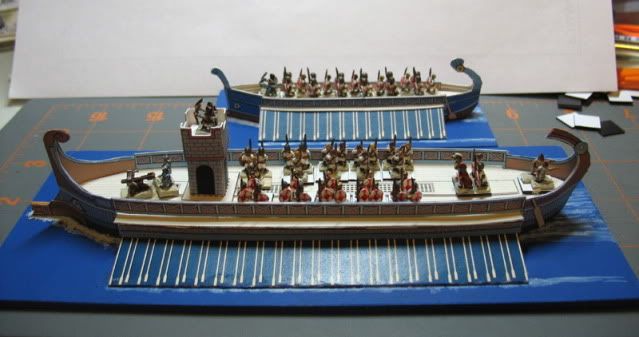
The latest massive ship in the Roman Seas navy
When Bob and I sat down at Brian's to play some Roman Seas in order to gear up for Historicon, I became enamored with the biggest ship on the table, the Trireme, and eagerly commandeered it. Rumor had it (basically Brian just told me) that Hotz ArtWorks also made a Quadreme model. There was a gleam in my eye. Over at Repple Depple, he does requests, and whipped up this mammoth, Hellenistic-era heavy warship. His navy is really taking shape, and looks fantastic. Remember, these are all paper models, Brian has just used color cardstock, some glue, and wood bases (except for the figures on deck, of course). The smaller ship in the background is a Liburnian. Okay folks, history time!
Pliny the Elder reports that Aristotle ascribed the invention of the quadrireme to the Carthaginians. Their first attested appearance is at the Siege of Tyre by Alexander the Great in 332 BC, and a few years later, they appear in the surviving naval lists of Athens. In the period after Alexander's death (323 BC), the quadrireme proved very popular: the Athenians made plans to build 200 of these ships, and 90 out of 240 ships of the fleet of Antigonus I Monophthalmus were "fours". In the Battle of Mylae in 36 BC, "fours" were the most common ship type fielded by the fleet of Sextus Pompeius, and several ships of this kind are recorded in the two praetorian fleets of the imperial Roman navy.It is known from references from both the Second Punic War and the battle of Mylae that the quadrireme had two levels of oarsmen, and was therefore lower than the quinquereme, while being of about the same width (ca. 5.6 m). Its displacement must have been around 60 tonnes, and its carrying capacity at ca. 75 marines. The "four" was classed as a "major ship" by the Romans, but as a light craft alongside triremes by Hellenistic navies like Egypt. It was especially valued for its great speed and maneuverability, while its relatively shallow draught made it ideal for coastal operations.
No comments:
Post a Comment